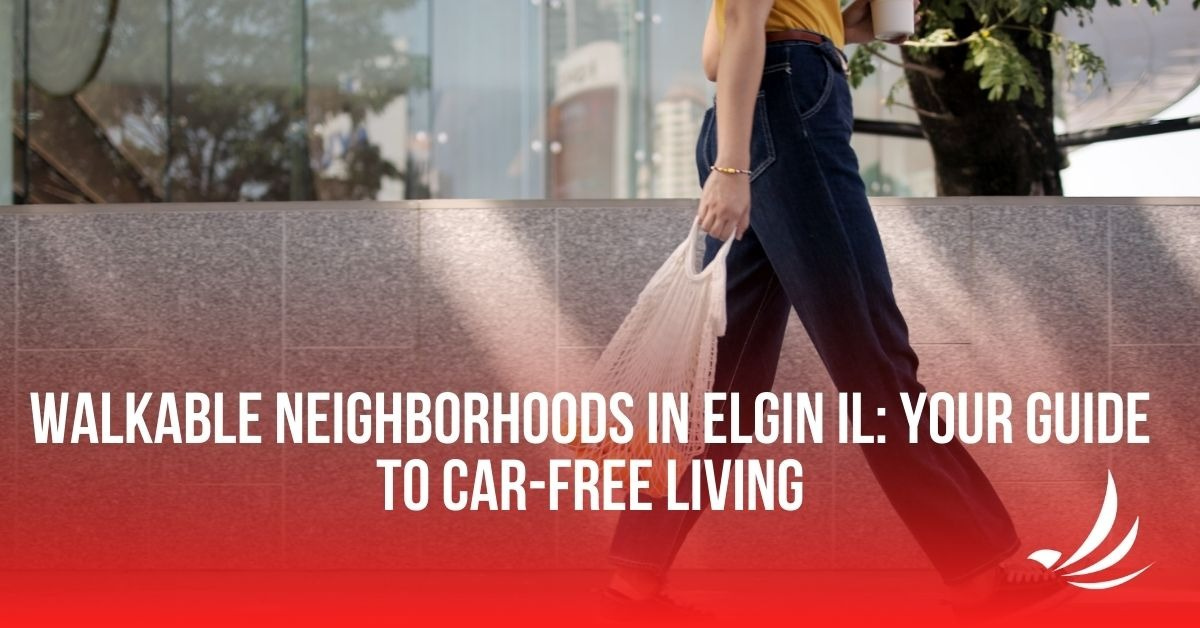Walkable Neighborhoods in Elgin IL: Guide to Car-Free Living
If you're dreaming of ditching your car keys and embracing a more pedestrian-friendly lifestyle, finding truly walkable neighborhoods Elgin IL requires understanding which areas genuinely support car-free living versus those that merely have sidewalks. While Elgin IL walkable areas are more limited than in larger cities, several neighborhoods offer the convenience of walking to shops, restaurants, parks, and transit that makes daily life possible without constant driving. This comprehensive guide reveals the best walkable neighborhoods in Elgin IL, helping you find communities where sidewalks lead somewhere meaningful.

Understanding Walkability in Elgin's Context
Before exploring specific pedestrian-friendly neighborhoods Elgin IL offers, it's important to set realistic expectations. Elgin developed primarily as a car-dependent suburb, meaning true walkability concentrates in select areas rather than spanning the entire city. The most walkable communities Elgin IL provides center around the historic downtown core and immediately adjacent neighborhoods, where density, mixed-use development, and established street grids create genuine pedestrian accessibility.
What defines walkability Elgin IL style differs from Chicago or other major urban centers. Here, walkable means having grocery stores, restaurants, and essential services within a 10-15 minute walk, reliable sidewalks connecting destinations, access to public transit for longer trips, and neighborhood designs that prioritize pedestrians over cars. While you might still own a vehicle for occasional use, these Elgin IL areas near shops and transit allow many daily activities without driving.
Downtown Elgin: The Heart of Pedestrian Living
Grove Avenue District: Where Everything Converges
Downtown Elgin stands as the undisputed champion of car free neighborhoods in the city, with Grove Avenue serving as the pedestrian spine connecting restaurants, shops, entertainment, and services. This historic commercial district features Al's Café & Creamery for afternoon treats, Elgin Public House on Douglas Avenue for dinner and drinks, and Villa Verone for special occasion Italian dining. The Martini Room adds upscale options while Kimmer's Ice Cream provides family-friendly desserts within the same walkable stretch.
Essential services cluster within easy walking distance. The Gail Borden Public Library Main Branch anchors the cultural corner, while Chase Bank, BMO Harris, and several other financial institutions handle banking needs. CVS Pharmacy on Grove Avenue and Walgreens nearby ensure prescriptions and daily necessities remain accessible on foot. The Elgin Post Office downtown location eliminates the need to drive for shipping, while multiple dental and medical offices in the Elgin Tower Building provide healthcare within walking distance.
The Elgin Transportation Center makes downtown the hub for anyone prioritizing neighborhoods with walking access Elgin to regional destinations. Metra's Milwaukee District West line connects to Chicago in about an hour, while Pace bus routes converge here, expanding your car-free range throughout the Fox Valley. This transit access transforms downtown from merely walkable to genuinely car-optional for many residents.
Downtown Living Options
Housing in downtown's walkable core includes the renovated Elgin Tower Building luxury apartments, offering stunning river views and immediate access to everything downtown provides. The historic YWCA conversion created modern lofts while preserving architectural character. New developments like the proposed riverfront condos will add more pedestrian-oriented housing, though current options remain somewhat limited compared to demand.
Rental prices for downtown's walkable units range from $900 for studios to $2,000+ for luxury two-bedrooms, reflecting the premium people pay for true walkability. Condos when available sell from $150,000 for older units to $350,000 for newly renovated spaces with river views. While these prices exceed typical Elgin suburban options, residents save significantly on transportation costs, often eliminating one or both vehicles from household budgets.
Historic Elgin District: Victorian Charm with Walkable Streets
Spring-Highland Neighborhood
The Elgin Historic District, centered around Spring Street and Highland Avenue, offers Elgin's second-best walkability combined with architectural beauty. These tree-lined streets feature sidewalks connecting Victorian mansions, Queen Anne cottages, and Prairie-style homes to downtown's amenities just blocks away. Residents here enjoy a 5-10 minute walk to Grove Avenue's restaurants and shops while living in spacious historic homes rather than apartments.
Daily conveniences nearby include the Spring Street Market for specialty groceries, Blue Box Cafe for morning coffee, and several neighborhood churches creating community gathering points. Lords Park sits within walking distance, providing 30 acres of green space, walking paths, the Family Aquatic Center, and even a small zoo. The park's proximity makes this one of the most desirable walkable communities Elgin IL offers for families wanting both pedestrian access and outdoor recreation.
Students living here can walk to Gifford Elementary School and Abbott Middle School, eliminating morning car lines for many families. The sidewalk network, while occasionally needing repair in older sections, connects reliably throughout the neighborhood. Street parking accommodates visitors without requiring driveways, maintaining the pedestrian-friendly streetscape that makes walking pleasant as well as practical.
Market Values and Housing Mix
Historic District homes command premiums for their walkability and character, with single-family homes ranging from $250,000 for smaller cottages needing work to $500,000+ for fully restored Victorians. The neighborhood's historic designation can complicate renovations but protects the architectural integrity that makes walking these streets special. Several homes have been converted to duplexes or apartments, providing rental options from $1,200-1,800 monthly for those wanting to experience living in Elgin's luxury areas.

Lords Park Area: Family-Friendly Walkability
Established East Side Living
The Lords Park neighborhood demonstrates how established areas in Elgin IL achieve practical walkability through decades of organic development. Centered around the park itself, this east-side neighborhood features a traditional grid pattern with complete sidewalk coverage, mature tree canopy providing shade for pedestrians, and a mix of housing types from bungalows to larger family homes creating diverse price points.
Lords Park serves as the neighborhood's recreational anchor with the Family Aquatic Center open summers, museum and cultural programming year-round, tennis courts, playgrounds, and athletic fields, plus the popular Lords Park Zoo. Families here walk or bike to activities rather than driving across town, creating natural community connections. The park's 30 acres provide enough variety that residents rarely exhaust their recreational options.
Commercial amenities along nearby Larkin Avenue include everyday necessities within reasonable walking distance. While not as concentrated as downtown, residents access Jewel-Osco for groceries, multiple restaurants including Toomey's Pub and Chili's, banking at Fifth Third and other institutions, and various professional services. The 15-20 minute walk might exceed comfort for daily groceries, but many residents use wheeled carts or make weekly trips, finding the trade-off worthwhile for the neighborhood's other benefits.
School Access and Family Life
Walkability to schools makes Lords Park particularly attractive for families seeking pedestrian friendly neighborhoods. Lowrie Elementary sits within the neighborhood, while Larkin High School is accessible via sidewalks for older students comfortable with the 20-minute walk. This school proximity eliminates morning driving stress while encouraging children's independence and physical activity.
Housing prices reflect the area's family appeal, ranging from $200,000 for smaller post-war homes to $400,000 for updated four-bedrooms with modern amenities. The variety means families at different economic levels can access this walkable lifestyle, unlike downtown's primarily rental options. Property taxes support the parks and schools that make the neighborhood desirable, but residents often find the walkable amenities offset these costs through reduced transportation expenses.
Wing Park District: East Side Suburban Walkability
Balancing Cars and Pedestrians
Wing Park represents a transitional walkable neighborhood where pedestrian infrastructure exists but full car-free living remains challenging. This established east-side area features the historic Wing Park Golf Club as its centerpiece, tree-lined residential streets with complete sidewalks, and proximity to both downtown and Larkin Avenue commercial areas creating partial walkability.
The neighborhood's layout supports pleasant walking for exercise and recreation, with Wing Park itself offering golf, tennis, and green space. Residents regularly walk dogs, jog, or stroll to the park, creating the social interactions that define strong family neighborhood communities. However, practical destinations like grocery stores require longer walks or short drives, making this area walkable-friendly rather than truly walkable.
Local businesses within walking distance include Wing Park Tavern for casual dining, Classic Cinemas for entertainment, and several small shops along Wing Boulevard. These destinations provide some pedestrian accessibility, but most residents maintain cars for major shopping and errands. The compromise works for those wanting walkable recreation and some local services while accepting occasional driving needs.
Festival Park Area: Emerging Walkable District
Downtown Adjacent Development
The Festival Park area represents Elgin's newest effort to expand walkability beyond the traditional downtown core. This riverfront district combines new residential development with public spaces, creating an emerging pedestrian-friendly neighborhoods Elgin IL is actively cultivating. The park itself hosts summer concerts, food truck gatherings, and community events, while planned mixed-use development will add ground-floor retail beneath residential units.
Current walkable amenities include direct riverfront trail access connecting to the larger Fox River Trail system, proximity to downtown's restaurants and services via the pedestrian bridge, and the Centre of Elgin recreation complex within walking distance. The Hemmens Cultural Center sits just blocks away, adding entertainment options. As development continues, this area promises to become increasingly walkable, though currently it requires downtown proximity to achieve true pedestrian convenience.
Housing here includes both new construction and renovated industrial buildings converted to residential use. The mix creates options from $1,000 studio rentals in converted factories to $300,000+ condos in new buildings with river views. Buyers here invest in future walkability potential as much as current conditions, betting on the city's continued downtown investment creating a more pedestrian-oriented district.
Comparing Walkability: Elgin Neighborhoods by the Numbers
Walk Score Analysis

These scores reflect practical reality: true walkability in Elgin concentrates in a few core neighborhoods. Areas scoring below 50 typically require cars for most errands, though they may offer pleasant walking for recreation. The transit scores remain modest throughout, reflecting Elgin's limited public transportation compared to major cities.
Cost-Benefit Analysis
Living in walkable neighborhoods Elgin IL often costs more upfront but saves money long-term. Downtown apartments commanding $200-400 monthly premiums over suburban units can save $500+ monthly by eliminating one vehicle (considering payments, insurance, gas, and maintenance). Families in the Historic District or Lords Park area might keep one car instead of two, saving $300-400 monthly while gaining walkable school access that enriches children's independence.
Property values in walkable areas typically appreciate faster than car-dependent neighborhoods, providing better long-term investment potential. The up-and-coming areas in Elgin often gain value specifically through walkability improvements like new sidewalks, transit access, or commercial development within walking distance.
Living Car-Free or Car-Light in Elgin
Practical Strategies for Success
Succeeding in car free neighborhoods requires adapting daily routines to pedestrian realities. Grocery shopping shifts from weekly car-loads to frequent walks with reusable bags or wheeled carts. Many downtown residents stop at Al's Café & Creamery or Apex Waterloo coffee shop on morning walks, combining exercise with errands. Online delivery supplements walking access, with Amazon, Instacart, and restaurant delivery filling gaps in pedestrian accessibility.
Weather presents the biggest challenge to year-round walkability in Elgin. Successful pedestrian residents invest in quality winter boots, waterproof clothing, and layering systems making walking comfortable in most conditions. Some maintain Divvy bike memberships or car-sharing accounts for extreme weather or longer trips, finding occasional vehicle use more economical than ownership.
Building Community Through Walking
Pedestrian neighborhoods naturally create more social connections than car-dependent areas. Regular walking to Elgin Public House or Villa Verone means recognizing neighbors, developing relationships with local business owners, and participating in spontaneous conversations impossible from inside vehicles. This social fabric becomes particularly valuable for young professionals new to Elgin or retirees seeking community connections.
Walking-oriented residents often organize informal groups, from morning coffee walks to evening dog-walking meetups. These organic communities strengthen neighborhood bonds while making walking more enjoyable and safer through natural surveillance. The Historic District's active neighborhood association particularly embraces walkability, organizing walking tours and advocating for pedestrian improvements.
Transportation Options Beyond Walking
Public Transit Integration
While walkability Elgin IL style doesn't match Chicago's comprehensive transit, strategic use of available options extends car-free range. The Metra station downtown provides hourly service to Chicago during peak times, with reduced weekend schedules. Pace buses, while limited, connect major destinations along fixed routes. Understanding these systems helps residents maximize car-free living potential.
The 301 bus route connects downtown to Randall Road shopping, expanding retail access beyond walking distance. Route 550 links to Schaumburg, opening employment opportunities without driving. While frequencies limit spontaneous travel, planning around schedules makes transit viable for many trips. Monthly passes reduce per-trip costs, making transit economical for regular commuters.
Biking as Walking Extension
Elgin's expanding bike infrastructure extends the range of "walkable" neighborhoods through pedal power. The Fox River Trail provides recreational riding and commuter routes, while new bike lanes downtown improve safety for urban cycling. Many residents find bikes bridge the gap between walkable and car-dependent, accessing destinations beyond comfortable walking distance without driving.
Bike-friendly amenities continue improving, with new racks appearing at businesses, repair stations along trails, and bike-sharing discussions ongoing. Combined with walking, cycling makes car-light living feasible in more neighborhoods than walking alone allows.
Safe neighborhoods in Elgin City often feature the infrastructure supporting both walking and biking.

Future of Walkability in Elgin
Planned Improvements
Elgin's commitment to improving walkability shows in recent planning documents and capital investments. The downtown streetscape project will widen sidewalks, add pedestrian lighting, and create more outdoor dining space. Proposed developments require pedestrian connectivity, ensuring new construction enhances rather than degrades walkability. The riverfront development plan prioritizes pedestrian access, potentially doubling downtown's walkable footprint.
Trail expansions will better connect outlying neighborhoods to the walkable core, while complete streets policies require considering pedestrians in all road projects. These improvements won't transform Elgin into Manhattan, but they'll expand options for residents prioritizing pedestrian-friendly neighborhoods Elgin IL continues developing.
Making Your Walkable Move
Choosing the Right Neighborhood
Selecting among Elgin IL walkable areas requires honest assessment of your pedestrian commitment. True car-free living remains feasible only downtown and the immediately adjacent Historic District. Car-light living works in Lords Park, Wing Park, and emerging areas like Festival Park, requiring occasional driving but enabling most daily activities on foot.
Consider your specific needs: families might prioritize Lords Park's school walkability over downtown's restaurant access. Young professionals might value downtown's transit connections for Chicago commutes. Retirees might prefer the Historic District's combination of walkability and quiet residential character. Visit potential neighborhoods multiple times, walking typical routes during different weather conditions and times to assess true pedestrian practicality.
Conclusion: Your Walkable Life in Elgin Awaits
While walkable neighborhoods Elgin IL offers remain limited compared to major cities, the options that exist provide genuine opportunities for pedestrian-oriented living. Downtown's true walkability, the Historic District's charming pedestrian access, Lords Park's family-friendly sidewalks, and emerging areas like Festival Park each offer different versions of car-free or car-light lifestyles.
The key to success lies in choosing neighborhoods matching your walkability priorities and adapting expectations to Elgin's suburban reality. Perfect scores might be rare, but the pedestrian-friendly neighborhoods Elgin IL provides offer compelling combinations of walkable amenities, community connection, and Illinois affordability that make car-reduced living both possible and enjoyable.
Ready to make your move to one of Elgin's walkable neighborhoods? Falcon Moving specializes in navigating these pedestrian-friendly areas, understanding the unique challenges of moving into historic buildings, downtown lofts, and established neighborhoods with limited parking. Our team knows these walkable communities intimately, ensuring your transition to pedestrian living starts smoothly. Explore our comprehensive Elgin City guide to understand how walkability fits into Elgin's broader appeal, or contact us to discuss making your car-free dreams reality in Elgin's most pedestrian-friendly neighborhoods.




